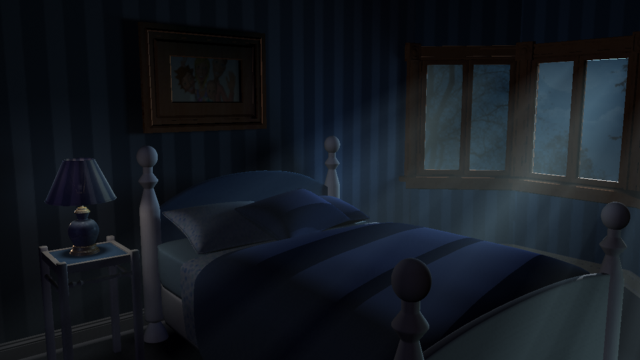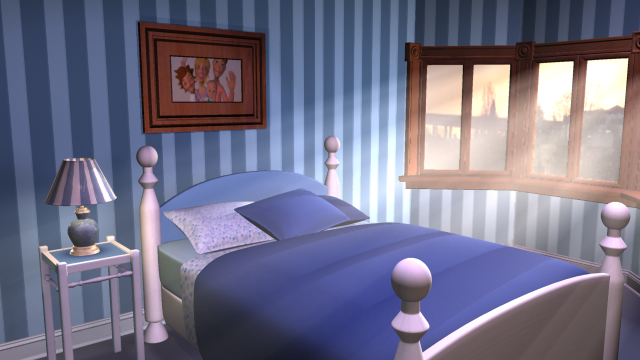Project 4b: Room Lighting
My Lecture notes are here.
Part 1: Copy what you see
For the first part of this assignment you are to match one of the two provided target images to the best of your ability.
- Choose either the night or day challenge. You will be using this theme for both parts of the assignment. There is a daytime room and a night room. For the dayime version dowload this image and this maya file. For the Night version, this image and this maya file.
- Constantly save iterations while your work! If a file becomes corrupt or you no longer like the direction you are going you can always go back.
- Light your scene. Do your best to match what is given to you. Look at where the light motivation is, what is the overall color of the scene, the intensity? Which diretion is the light coming from, where are the shadow casting lights, where do you need fills, rims? Decide what kind of light will get you the effect you need.
- Use a variety of light types, experiment. Keep in mind that some effects that work with maya software and depth map shadows will not work with raytracing
- For a basic explanation of each light type go here -> http://download.autodesk.com/global/docs/maya2012/en_us/ and search lights in the search function.
- Making a shadow light: to make a shadow light you will have two lights sitting exaclty on top of each other.
- make a spotlight, call it (object casting shadow)_shadow_light (ex: lamp_shadow_light).
- Turn off illuminates by default
- turn on shadows
- link it to the thing that is casting the shadow and the thing that the shadows are being casted on (say the floor)
- leave the intesity at one, you will adjust this up or down as needed as this is how you will controll the darkness/intensity of the shadow
- position the light where you want it
- duplicate that light (ctrl +d)
- name the copy of your light (object casting shadow)_negative_light (ex: lamp_negative_light)
- turn off shadows
- link it to the same objects as the shadow light (duplicating does not copy your light links)
- make the intestiy the negative intensity of your shadow light (-1, if the shadow light is 1, etc)
- remember this light will need to have the exact same position, cone angle and prenumbra settings as your shadow light
- render and adjust as needed
- note: the color of the lights will affect the color of the shadow
-
DO NOT use Photoshop to tweak the lights in your scene. Do all of the work in Maya.
DO NOT change geometry, shaders or camera settings.
Make sure to use raytrace shadows and to render in mental ray. Note that this means IPR will not be useful as it does not do raytracing. While working you will want to use preview render settings. To do so go to Windows -> Rendering Editors -> Render Settings. In the Quality tab make sure that then Quality Presets dropdown box is set to Preview Quality
- Render your scene. The next step is to render you scene. Go to Windows -> Rendering Editors -> Render Settings. In the Quality tab make sure Quality Presets are set to Production. In the 'common' tab, change the Image format to PNG. Scroll down to the Image Size section and change Width to 1280 and Height to 720 and hit the render button making sure to render from render_cam. Save the image by right clicking on the rendered image and go to File -> Save Image. Name it lastname_firstname_beauty_part1_project4b.png. Your beauty render is your high quality render straight out of maya with no additional render passes (which you will learn about later in class).
- Render occlusion pass. THIS IS OPTIONAL
- Below the channel box is the layer window. Click on the Render tab. Select all the physical objects in your scene besides the view_outside object (do not select any lights or texture placement nodes). Go to Layers -> Create Layer From Selected. Rename your layer to occlusion pass by double clicking the layer name
- Right click the layer and select Attributes. Make sure the occlusion tab is selected. Go to Presets -> Occlusion
- Change Samples to 250, Spread to 1, and Max Distance to 3.
- Make sure the render layer is selected and render from camera_1.
- Bring both renders into separate layers in Photoshop. Make sure the occlusion layer is above the rendered scene. Use the Multiply Blend Node and save your image
Part 2: Improve what you see
For part 2 you will use the result from part 1 as a starting point (copy your maya file). You will modify your lighting from part 1 and use one of the following three moods as a target for your assignment. Pick a specific mood from the following list; sad, happy, or fearful and be sure to select two reference images that inspired you. The staff and students will guess which mood you've selected so prepare by showing friends and family and getting their response. As part of your critique analysis for part 1 you will need to provide the name of the mood that you selected for part 2.
If you picked nighttime for part 1, it must still clearly be nighttime in part 2. The same goes for if you picked the daytime room. So if you have picked, say, sadness or fear, consider how it would be different lighting for daytime versus if you are lighting for nighttime. The same for happiness.
- Gather reference. Gather at least two pieces of visual reference that supports the theme (day or night) and mood you have chosen. The references you choose can be paintings, photographs, film, etc. Use the reference to adjust your lights to excentuate the mood you are working with. This could involve shifting the colors (say to green if you are going for fear, for example), the contrast or the angle of the lights and sharpness or length of shadows.
- Constantly save iterations while your work! If a file becomes corrupt or you no longer like the direction you are going you can always go back.
- Your ultimate goal is to convey a particular mood with your lighting. Pay close attention the distribution of light and color throughout
your scene. Bad lighting is typically very flat, while good lighting
contains gradations. It is generally more visually interesting
to juxtapose at least two colors.
As much as possible, you should motivate your lights. This means that the viewer should be able to understand where each light is coming from such as a window, light fixture, or a fire. This is a fairly loose guideline, but one you should think about. You should also use contact shadows where needed. An object on the ground typically casts a shadow below it. If you forget these shadows, your overall lighting will suffer for it.
Lighting is an art, not a science. Use reference. However, keep in mind that the purpose of reference is not to provide you with something to slavishly copy, but to show you what good lighting looks like.
Make sure we can see your scene. Pools of dark and dim light can be effective when deployed in the right places, but if the overall brightness level is so dark that it is difficult to see what is going on, then that is no good.Experiment! Play with effects, don't be afraid to try things. For example:
Keep in mind that if you use an effect it still has to support your mood.

or

For instructions on creating light rays through your windows. There are a few ways to do this, here is one: Light Rays 101
You can also acheive a similar effect by adding a light fog to a spot light.
-
DO NOT use Photoshop to tweak the lights in your scene. Do all of the work in Maya.
DO NOT change geometry, shaders or camera settings.
Make sure to use raytrace shadows and to render in mental ray. Note that this means IPR will not be useful as it does not do raytracing. While working you will want to use preview render settings. To do so go to Windows -> Rendering Editors -> Render Settings. In the Quality tab make sure that then Quality Presets dropdown box is set to Preview Quality.
- Render your scene. The next step is to render you scene. Go to Windows -> Rendering Editors -> Render Settings. In the Quality tab make sure Quality Presets are set to Production. In the 'common' tab, change the Image format to PNG. Scroll down to the Image Size section and change Width to 1280 and Height to 720 and hit the render button making sure to render from render_cam. Save the image by right clicking on the rendered image and go to File -> Save Image. Name it lastname_firstname_beauty_part2_project4b.png
- Render occlusion pass. THIS IS OPTIONAL
- Below the channel box is the layer window. Click on the Render tab. Select all the physical objects in your scene besides the view_outside object (do not select any lights or texture placement nodes). Go to Layers -> Create Layer From Selected. Rename your layer to occlusion pass by double clicking the layer name
- Right click the layer and select Attributes. Make sure the occlusion tab is selected. Go to Presets -> Occlusion
- Change Samples to 250, Spread to 1, and Max Distance to 3.
- Make sure the render layer is selected and render from camera_1.
- Bring both renders into separate layers in Photoshop. Make sure the occlusion layer is above the rendered scene. Use the Multiply Blend Node and save your image